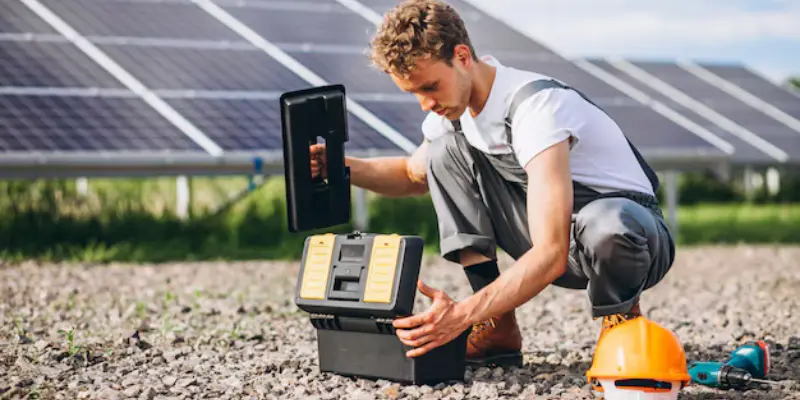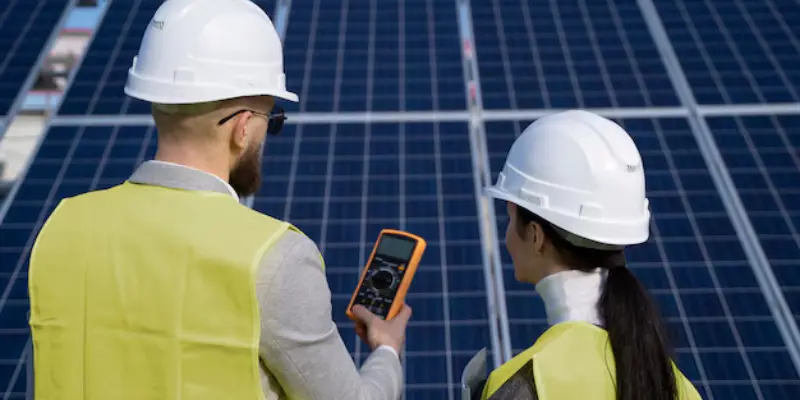Solar Panel Inspection: A Step-by-Step Complete Guide
Updated: 24 Dec 2024
154

Introduction
Solar panel inspection is the process of evaluating your solar panels’ condition and performance to ensure efficiency and safety. It helps identify issues like physical damage or electrical faults that could affect performance. Routine inspections reduce risks, improve energy production, and ensure compliance with safety standards. Timely checks keep your system running efficiently, saving you money and preventing costly repairs.
Don’t let small issues turn into big problems! Schedule your inspection today to protect your investment and keep your solar system performing at its best.
What is Solar Panel Inspection?
Solar panel inspection is the process of evaluating your solar panels’ condition and performance to ensure efficiency and safety. It helps identify issues like physical damage or electrical faults that could affect performance. Routine inspections reduce risks, improve energy production, and ensure compliance with safety standards. Timely checks keep your system running efficiently, saving you money and preventing costly repairs.
Why Solar Panel Inspection Matters
Regular inspections are crucial for maintaining the longevity and efficiency of your solar panels. They help identify potential issues early, reducing risks and improving overall system performance. For homeowners and business owners, timely inspections ensure that the system operates at its peak efficiency, providing long-term savings and preventing unexpected costly repairs.
Why is Solar Panel Inspection Important?

Ensuring System Efficiency:
- Regular solar panel inspections are essential to maintaining and improving energy production. Inspections help identify underperforming panels or system inefficiencies before they become major issues.
- Example: “Regular inspections ensure your system operates at its full potential, preventing performance drops and maximizing energy production.”
Safety and Compliance:
- Inspections also ensure that solar panels meet local safety standards and regulations. They help identify potential electrical faults, physical damage, or improper installation that could lead to safety hazards.
- Example: “Solar panels must comply with safety codes to avoid electrical fires or other system failures.”
Maximizing Longevity
- Routine inspections can extend the life of your solar panels by detecting early signs of wear, such as corrosion or faulty wiring. Catching issues early helps prevent costly repairs and replacements.
- Example: “Regular checks help avoid small issues that can escalate into expensive repairs or shorten the lifespan of your panels.”
Key Aspects of a Solar Panel Inspection
1. Visual Inspection of Solar Panels
- Start by inspecting the surface of the panels for cracks, dirt, or debris that could obstruct sunlight and reduce efficiency. Even small obstructions can lower the amount of energy generated by the system.
- Example: “Inspecting for dirt or shading ensures panels receive maximum sunlight for optimal performance.”
2. Inspecting Electrical Connections and Wiring
- Check the wiring, connections, and the inverter for any signs of wear or damage. Loose, frayed, or exposed wires can pose serious safety risks and reduce the overall efficiency of the system.
- Example: “Loose or frayed wires can reduce efficiency and increase the risk of electrical hazards.”
3. Testing and Measuring Performance
- Performance tests, like I-V curve testing and efficiency checks, are vital to ensure that each panel is producing the expected energy output. These tests help spot underperforming panels early on.
- Example: “Testing ensures that each panel is producing the expected energy output, maximizing your system’s efficiency.”
4. Structural Integrity and Mounting Systems
- Ensure that the mounting frames are secure and free from corrosion. Damaged or loose frames can lead to misaligned panels, which could cause performance issues or premature panel failure.
- Example: “A damaged frame can cause panel misalignment, leading to reduced efficiency or early failure of your solar system.”
| 5 Expert Tips to Keep Your Solar Panels Running at Their Best |
|---|
|
How to Conduct a Solar Panel Inspection: A Step-by-Step Guide
1. Prepare for the Inspection
- Gather the necessary tools, safety gear, and documents, including permits and manuals. Make sure you have everything needed before starting the inspection.
2. Perform Visual Inspection
- Examine the panels, wiring, and overall system setup for any visible issues such as dirt, cracks, or damage. This step helps identify any obvious problems that need attention.
3. Check Electrical Components
- Test all electrical connections and ensure that everything is functioning properly. This includes checking the inverter, wiring, and circuit breakers to make sure there are no loose connections or faults.
4. Measure Performance
- Use tools like a multimeter or I-V curve tester to measure energy output and verify that the system is generating power efficiently. This step helps ensure the panels are performing as expected.
5. Post-Inspection Actions
- Document your findings, noting any issues or required repairs. Address any problems immediately to prevent further complications and ensure the system is operating optimally.
Who Should Perform the Inspection?
While some simple inspections can be done by homeowners, it’s recommended to hire a professional for more complex inspections, especially those involving electrical components or advanced performance testing.
Common Solar Panel Inspection Mistakes to Avoid
Neglecting Regular Inspections: Skipping regular inspections increases the risk of undetected issues, which can lead to costly repairs or system failures. Regular checks are crucial to maintaining optimal performance and avoiding expensive fixes down the line.
Ignoring Small Issues: Small defects, if left unaddressed, can develop into major problems over time. What might seem like a minor issue can escalate and lead to more severe damage, affecting the overall efficiency of the system.
Not Using Proper Equipment: Using incorrect or outdated tools can lead to inaccurate assessments of the solar system’s performance. To ensure precise measurements and effective problem detection, it’s essential to use the right equipment for the job.
Conclusion
Solar panel inspections are essential for maintaining performance, ensuring safety, and saving on costly repairs. Regular inspections help detect issues early, improve energy efficiency, and extend the lifespan of your solar system
Take control of your solar system today! Fix common issues yourself, save money, and keep your energy flowing efficiently. Don’t wait—your savings and energy efficiency are just a step away!
How do you inspect a solar panel?
A thorough inspection starts with a visual check for cracks, dirt, or debris that could block sunlight and affect performance. Regular cleaning and removing obstructions are key to maintaining optimal energy production.
How do I get my solar panels checked?
To check your solar panels, start by reviewing the solar meter and inverter to ensure they are working properly. Inspect for obstructions, check the wiring, and look for signs of corrosion. If necessary, contact your solar installer for a professional inspection.
How do you know if your solar panels are working properly?
To determine if your panels are functioning properly, check the weather (since cloudy days reduce energy output), review the inverter display, monitor your solar meter, and look at your electric bill for changes in energy usage.
What is a PV inspection?
A solar PV inspection evaluates the condition and performance of photovoltaic panels, ensuring they are functioning optimally. It involves various techniques, such as electrical testing and imaging, to detect any potential issues.
How can I check the quality of my solar panels?
Check for certifications from trusted organizations like the International Electrotechnical Commission (IEC) or Underwriters Laboratories (UL). These certifications ensure your panels meet safety and performance standards.
How to test solar panels with a multimeter?
To test your solar panels, set the multimeter to DC voltage mode and connect the red lead to the positive terminal of the panel. Place the panel in sunlight and note the voltage reading on the multimeter to confirm it’s generating power.
What is solar testing?
Solar testing ensures that your system components, including panels and inverters, meet quality and safety standards. It helps guarantee optimal performance, reduce risks, and ensure your system is reliable long-term.
How often should solar panels be inspected?
Solar panels should be inspected at least once a year to ensure they are operating efficiently. For areas with harsh weather, bi-annual inspections are recommended to catch potential issues early.
What qualifications do I need to inspect solar panels?
Professionals inspecting solar panels typically need certifications like NABCEP (North American Board of Certified Energy Practitioners). This ensures they have the skills to perform detailed inspections in compliance with local codes.
What are the most common issues found during solar inspections?
Common issues include dirt or debris blocking sunlight, damaged wiring, and malfunctioning inverters. These problems can reduce efficiency and, if left unaddressed, can lead to system failure.
How much does a solar panel inspection cost?
The cost of a solar panel inspection generally ranges between $100 and $300, depending on the size of the system and the complexity of the inspection. Specialized tests or hard-to-reach installations may increase the cost.
Please Write Your Comments